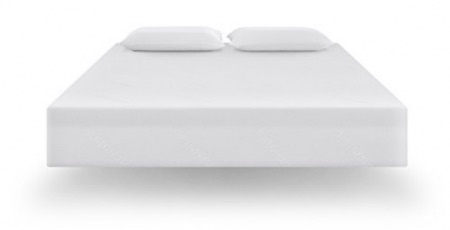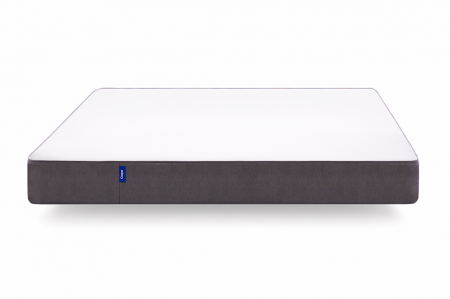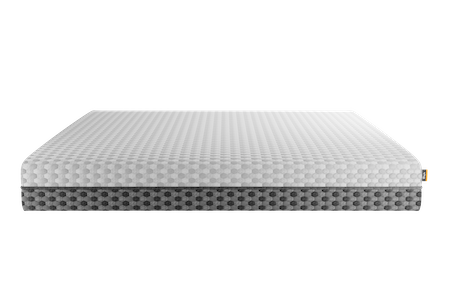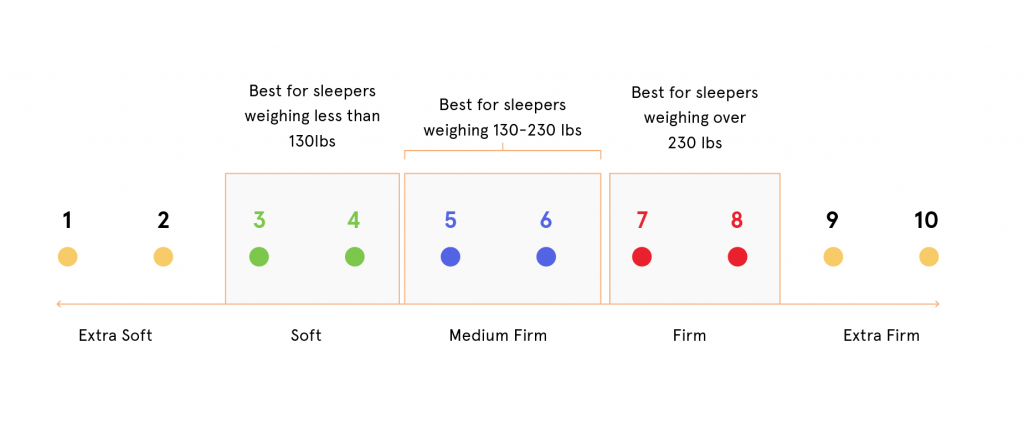Choosing Your Mattress Type
Now that you know what’s different about buying a mattress on Amazon.com, what else do you need to know about buying a mattress? To find the best mattress for you, it’s helpful to understand the different types of mattresses available today, what your optimal firmness rating is, and other mattress qualities that may enhance your sleep experience. We’ll discuss each of these in the following three sections.
Five main mattress types exist today. These include foam, innerspring, hybrid, latex, and airbed models. All of them are available on Amazon.com.
Foam mattresses use foam in all layers of their construction, with high-density polyfoam in the support layer and comfort layers of polyfoam, memory foam, or latex foam.
The all-foam construction creates a surface that absorbs movement very well, so these beds tend to stay quiet and still when bearing weight.
Foam mattresses are either loved or hated for their pressure-relieving “hug.” These mattresses conform closely to the body, offering unmatched pressure point and pain relief. However, that hugging sensation can also lead to trapped body heat and a mattress surface that’s less conducive to sex.
Best for: Foam beds are ideal for sleepers with chronic pain, light sleepers, couples, and shoppers on a budget. If you’re a hot sleeper who wants to enjoy the pressure relief of memory foam, look for models that use cooling materials like gel or copper in their comfort layers, like the Nectar, Purple, or Layla mattresses.
Average Price: $900 to $1,200 for a Queen
Pros:
- Superior conforming and pressure relief
- Excellent motion isolation
- Quiet sleep surface
Cons:
- Can have a tendency to trap heat
- Poor edge support
- May not be sufficiently responsive for sex
Innerspring mattresses use a uniform innerspring coil grid for their support layers, with comfort layers of polyfoam, memory foam, or minicoils.
Thanks to their coil-based support system, innerspring mattresses tend to sleep very cool. They’re also very responsive and suitable for sex. The uniformity of the support layer ensures evenly distributed support, and also provides excellent edge support.
However, the coil grid also makes these beds less adept at motion isolation, which can result in a noisier sleep experience. Also, the pressure relief of an innerspring mattress will depend largely on the thickness of the comfort layers, with thicker comfort layers typically equating to a softer feel with more conforming.
Best for: Innerspring beds are ideal for hot sleepers, those needing even support, couples, and shoppers on a budget.
Average Price: $900 to $1,150 for a Queen
Pros:
- Superior temperature regulation
- Excellent bounce and responsiveness for sex
- Strong edge support
Cons:
- Can be prone to sagging
- Poor motion isolation and potential for noise
- Below-average conforming ability
Hybrid mattresses combine features from innerspring and foam models. The support core uses a coil-based system, but instead of an uniform innerspring grid, hybrid beds use individually pocketed coils. This results in better motion isolation, a quieter sleep surface, and slightly more contouring.
The comfort layers are also much thicker than an innerspring bed, including at least a few inches of memory foam or latex. As a result, these beds offer significantly more conforming and pressure relief. Due to their thicker construction, hybrid mattresses have taller profiles and strong edge support, which can be helpful for those who have difficulty getting into and out of bed.
Best for: Hybrid beds are ideal for sleepers with chronic pain, light sleepers, couples, those who typically sleep hot on all-foam beds, and those needing strong edge support.
Average Price: $1,800 to $2,200 for a Queen
Pros:
- Above-average conforming and pressure relief
- Good motion isolation and low noise potential
- Strong edge support
Cons:
- Average lifespan and durability
- Expensive price range
- May sleep hot, depending on the thickness and composition of the comfort layers
Best Latex Beds on Amazon
Mattress Reviews
Sleep on Latex Mattress Review
Latex mattresses use high-density latex or polyfoam in their support layer, with comfort layers of latex.
Latex mattresses may be described as all-latex (indicating that the mattress is made entirely of natural latex), synthetic latex (indicating that the mattress is made from synthetic latex foams), or blended latex (indicating that the mattress contains a mix of natural and synthetic latex foams, with at least 30% organic latex).
Latex mattresses made from organic latex, like the Pure Green Mattress, tend to sleep very cool, and boast significantly longer lifespans than other mattress types.
Latex mattresses have a unique feel that can take a little getting used to for first-time buyers, but satisfied owners report high levels of support and good contouring from these mattresses. Latex beds also offer a quiet sleep surface that’s still bouncy enough for sex, making them popular among couples.
Best for: Latex beds are ideal for sleepers with chronic pain, hot sleepers, couples, and those seeking a highly durable mattress.
Average Price: $1,800 to $2,150 for a Queen
Pros:
- Higher durability and longer lifespans
- Great temperature regulation
- Excellent motion isolation and quiet sleep surface
Cons:
- Poor edge support
- More expensive price range
- Can sleep hot, if mostly synthetic foams are used
Airbeds use air for support, with individual air chambers that can be adjusted by the sleeper using a manual hand crank or remote control. Airbeds typically feature thinner comfort layers of foam, or no comfort layer at all.
The standout feature of airbed mattresses is their adjustable firmness. Sleepers can fine-tune the bed’s firmness to their exact preferences, which is useful for those with varying firmness needs due to an injury or a change in body weight or sleep position.
Best for: Airbeds are ideal for sleepers with shifting firmness preferences, those with chronic pain, and shoppers looking for a highly durable mattress.
Average Price: $2,100 to $2,400 for a Queen
Pros:
- Higher durability and longer lifespans
- Good conforming and pressure relief
- Adjustable firmness settings
Cons:
- Average motion isolation and high noise potential
- Can sleep hot
- Expensive price range
Selecting Your Mattress Firmness Level
Today’s mattresses come in a range of firmness settings, from soft to firm. At Tuck, we equate these to a 1 to 10 scale, with ‘Soft’ being a 3 and ‘Very Firm’ being an 8. The best mattress firmness setting for you depends on your body weight, sleep position, and personal comfort preferences.
Mattress Firmness Settings by Body Weight
- Lightweight sleepers (who weigh less than 130 pounds) find softer mattresses more comfortable, ranging from ‘Soft’ to ‘Medium Firm.’
- Average-weight sleepers (between 130 and 230 pounds) find ‘Medium’ or ‘Medium Firm’ mattresses most comfortable.
- Heavier sleepers (who weigh more than 230 pounds) receive the most support from firmer mattresses, ranging from ‘Medium Firm’ to ‘Very Firm.’

Mattress Firmness Settings by Sleep Position
- Side sleepers require softer mattress surfaces. These allow wider areas of the body, like the hips and shoulders, to sink deeper into the mattress so the spine can stay aligned. Side sleepers may choose a softer firmness setting in the recommended range for their body weight. For example, a lightweight side sleeper may prefer a ‘Soft’ mattress while a heavyset side sleeper may prefer a ‘Medium Firm’ or ‘Firm.’
- Back sleepers enjoy ‘Medium’ to ‘Firm’ mattresses, depending on their body weight and personal preferences. The mattress should be soft enough to allow their hips to sink more deeply, without being too soft so as to allow an unnatural curvature in their spine.
- Stomach sleepers prefer firmer mattress surfaces. With a mattress that is too soft, the stomach may sink too far into the mattress surface, pulling the lower back out of alignment and causing discomfort. A ‘Medium Firm’ to ‘Very Firm’ mattress prevents this.
The table below summarizes the popular firmness settings for sleepers by weight group and sleep position:






